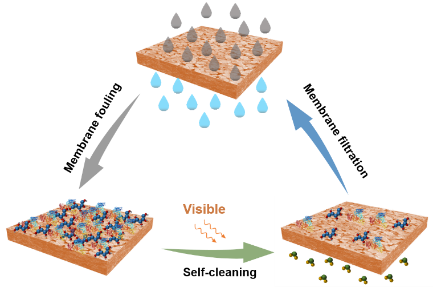
Researchers from the Institute of Process Engineering (IPE) of the Chinese Academy of Sciences and Argonne National Laboratory (Argonne) in the U.S. have recently employed atomic layer deposition (ALD) to fabricate visible light-activated membranes that efficiently utilize solar energy.
The study was published in Advanced Functional Materials on June 30.
This research is important because membranes are among the most promising means of delivering increased supplies of fit-for-purpose water. However, membrane fouling remains a critical issue restricting their widespread application.
The modified membrane in this study exhibits outstanding antifouling and in situ self-cleaning performance under visible light irradiation.
Coupling photocatalysis with membrane separation has previously been proposed as a potentially effective way to reduce membrane fouling. However, materials used in photocatalysis limit the use of low-cost sources such as sunlight due to their large bandgaps.
To solve this problem, the researchers fabricated a visible light-activated photocatalytic film by doping nitrogen into the lattice of TiO2 deposited on commercial ceramic membranes using ALD.
The N-TiO2 coating endowed membranes with a capacity for effective in situ self-cleaning and enhanced stability under solar irradiation owing to the redox reactions between organic foulants and generated reactive oxygen species (ROS) as well as the increase in surface hydrophilicity.
The synergy between membrane separation and redox reactions involving organic pollutants and ROS produced by the visible light-activated layer suggests a possibility for stable and sustainable membrane operation under in situ solar irradiation.
The researchers also highlighted the importance of ALD technology in fabricating the membranes.
Prof. LUO Jianquan from IPE said that the study "opens a door" to applying ALD technology to membrane surface modification for fouling control.
Seth B. Darling, a co-author from Argonne, noted that the current research is "among the first successful demonstrations of real-time self-cleaning of a membrane during operation." He also said that ALD is a powerful tool for improving the performance of membrane separations beyond fouling mitigation.
N-doped photocatalytic films and ALD offer promise for using solar energy to effectively control membrane fouling and for establishing a sustainable membrane separation system.

Schematic diagram of N-TiO2 and TiO2 coated membrane preparation and mechanism of visible-light-activated photocatalysis for fouling mitigation (Image by ZHANG Huiru)

86-10-68597521 (day)
86-10-68597289 (night)

52 Sanlihe Rd., Xicheng District,
Beijing, China (100864)

